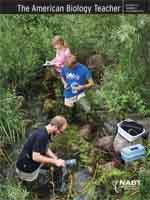Introducing students to the process of scientific inquiry is a major goal of high school and college labs. Environmental toxins are of great concern and public interest. Modifications of a vertebrate developmental toxicity assay using the frog Xenopus laevis can support student-initiated toxicology experiments that are relevant to humans. Teams of students formulate hypotheses, perform experiments, analyze data, and present their results. By performing experiments to investigate the toxicity of household chemicals, pharmaceuticals, or agricultural chemicals, students will gain an appreciation of the environmental effects of improper disposal of common chemicals and industrial or agricultural run-off.
How to translate text using browser tools
1 September 2012
Introducing Environmental Toxicology in Instructional Labs: The Use of a Modified Amphibian Developmental Toxicity Assay to Support Inquiry-Based Student Projects
Roger Sauterer,
James R. Rayburn
ACCESS THE FULL ARTICLE
It is not available for individual sale.
This article is only available to subscribers.
It is not available for individual sale.
It is not available for individual sale.

The American Biology Teacher
Vol. 74 • No. 7
September 2012
Vol. 74 • No. 7
September 2012
amphibian
embryos
Environmental toxicology
inquiry-based learning
teratogen




